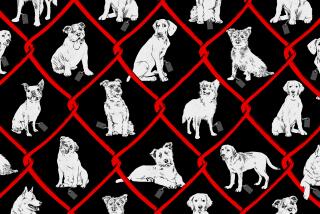Pet Social Worker’s Style Is Going to the Dogs : Warren Eckstein Makes a Healthy Living Providing Therapy for Animals
- Share via
Warren Eckstein calls himself the Leo Buscaglia of dog-human relations. “I’ll be walking down the street and somebody will be walking a dog,” the 37-year-old New York native said. “Not thinking, I’ll bend down, give the dog a kiss and continue to walk, never saying a word to the owner. Only later will I wonder what that person must have thought.”
Such antics have landed him a radio talk show in New York, regular appearances on “Hour Magazine,” guest spots on the “David Letterman Show” (including a “Tribute to Rodents” and “Basic Pig Training”) and a booming bicoastal business as a “pet social worker.” He has also authored two books: “Yes Dog, That’s Right” (a basic dog training manual) and “Pet Aerobics.” In January, Holt, Rinehart & Winston will publish “Understanding Your Pet: The Eckstein Approach to Behavior.”
For $100 to $300 an hour, plus expenses, he will visit pet and owner at home, observing the former and interviewing the latter, assess their environment, and recommend a treatment designed to make at least one of them happier. Although dogs make up the brunt of his caseload, he also works with cats, birds, pigs, goats, goldfish and--once--a tarantula.
Not surprisingly, Eckstein reports he has “always been an animal fanatic.
“I remember as a young child on Long Island there was a creek behind my house,” he said. “I brought home a rat, convinced my parents it was a muskrat gone bald, named it and kept it in my house for six months until my parents got the idea that the hair wasn’t growing back and that it was just an old brown rat. But he was a good friend.”
Today, Eckstein lives in a farmhouse outside Albany, N.Y., with his wife, Fay, two pigs, two hamsters, a guinea pig, six chickens, six ducks, five dogs, 22 rabbits, a mouse, two gerbils, a hamster and two parrots. When at home, he often jogs with his two pigs, Spot and Corky.
When he is away, Eckstein calls home to talk to his dogs over the speaker on his telephone answering machine. “I’ll say, ‘Hi Tige, Hi Shannon, Hi Shep, Hi Muggs, Hi Honey. There are bones for you upstairs and we’ll play soccer when I get home.’ ”
A large part of pet-human relations, Eckstein contends, is showing the animal affection. “If he’s doing something right, hug and kiss the dog,” Eckstein said. “I have yet to see a dog that has received a lot of hugging and kissing that wasn’t pretty well adjusted.”
Hands-and-Knees Approach
Getting down on hands and knees is also important, Eckstein believes, because dogs have problems communicating with upright, two-legged humans. “The reason dogs jump up on people is that they want to communicate,” he said. “Can you imagine living in a society where everyone around you is 15 feet tall? The only way you have of communicating is to jump up on them.”
He suggests that dog owners spend 15 minutes each day on hands and knees playing with their dogs. “You’ve gotten that need for communication out of his system,” Eckstein said.
He calls himself a pet social worker instead of a pet psychologist or animal trainer because he believes there are few bad animals, just animals reacting to stress, fear or other noisome conditions.
Perhaps another reason for his non-traditional job title is his lack of traditional educational credentials. His bachelor’s degree is in human psychology. After graduation, he studied under European animal behavioralists, but did not earn a graduate degree. Eckstein considers his most important qualification the thousands of pets he has observed and treated.
A Part of the Family
“The problem is you can’t take an animal, put it in a human environment, treat it like an animal, and expect it to act like a human,” he said. “I don’t even accept the word pet so much any more. They are really family members now.”
He believes owners should strive to have a socially well-adjusted pet, not merely a pet that is obedient. “I have people who once a week have a party for their pets,” he said. “Neighbors--both people and pets--come. There is a bridge mix for the people and a bridge mix for the pets. They can all socialize.
“I also suggest people taking their dogs or cats on picnics, or a trip to the beach or a ride in the car.”
Pet relaxation is important, Eckstein argues, because changing life styles in the 1980s have “transferred stresses from one end of the leash to the other.”
For example, he sees problems particular to the upwardly mobile pet. “The two-income family that postpones child-bearing for a few years . . . will often adopt a dog to essentially be the kid,” he said. “They bring presents for it. They ‘ooh’ and ‘ah’ over it. The grandparents come over and call it the ‘grandpuppy’ or the ‘granddog.’
“Two years down the line it is time for baby number one. Suddenly this dog is being shunned. I don’t accept that. I make people stop and tell them that if they are going to play with the baby, they must play with the pet. The pet was there first.
“Otherwise, there can be a sibling rivalry between pet and baby.”
He contends that most problems with dogs stem from three common situations: The dog is never given a chance to show dominant behavior, it is treated inconsistently, or it does not receive adequate exercise.
“You go to the typical American family: Ma, Pa, 2.5 kids and Grandma and Grandpa living around the corner,” he said. “Everyone is consistently telling the dog ‘Do this. Don’t do that. Correct this. Correct that.’
‘Dog Is the Only Indian’
“The problem is . . . you have all chiefs and the dog is the only Indian. So any time it has a chance to show some dominant behavior, be it with a child or a neighbor, the dog is going to take full advantage, and understandably so. If everyone in my household was above me, I was the only member and everyone else was the leader, I would be challenging the same way.”
He maintains that animal behavior problems are aggravated when pets are bored and out of shape. “You see obese cats that can’t jump on the furniture anymore and dogs that don’t chase cats anymore,” he said.
Included in “Pet Aerobics” are directions on puppy push-ups, doggie sit-ups, jumping jacks and dog dancing. “If a dog can lie down and stand up and you get it to go down, up, down, up, you have a push-up. Sit, stand, sit, stand, you have a sit-up,” he said.
Another exercise he recommends is dog dancing. “It is incredible how many closet dog dancers I found when I was putting the book together,” he said.
“When a good song comes on the radio,” he said, the owners will “pick up those dogs’ legs and they’ll dance around the room with them.”
Other athletic activities he recommends for pets are hiking (“They make backpacks for dogs”), jogging, speed walking, soccer, Frisbee and tetherball.
Perhaps the best illustration of Eckstein’s unusual brand of social work is to select a few of the 30,000 cases he has worked over the last 16 years.
One was the case of a dog whose owner had been through a bitter divorce in which “the husband would come home and yell and scream and sometimes take his aggressions out on the dog,” Eckstein said.
Dog Overly Protective
“A woman called me up and said ‘Warren, I can’t date.’ I said, ‘Maybe you’re calling the wrong therapist.’ But the problem was that her dog would not accept any man coming near her in that house. The dog felt challenged and threatened and became overly protective.”
He said the woman had consulted several mainstream animal behavioralists who suggested she get rid of the dog or correct its behavior with a system of rewards or punishments. Eckstein said his suggestion was to “put the dog on the couch” and deal with the underlying problem.
“It was a fear response on the dog’s part,” he said. “I took a desensitizing approach. I used a cassette tape recorder and taped men speaking very softly. I came to the house as a potential date, brought flowers for the woman and dog biscuits for the dog to establish a relationship.
“Then I had her take the dog out to meet me on the street in a non-threatening situation. The dog didn’t have to protect his turf. It took about 3 1/2 months, but it worked out fine.”
Sixteen years ago, friends and acquaintances literally found Eckstein’s career aspirations unbelievable. “But now it’s worse than being a doctor or a lawyer,” he said. “Everybody has a question about their pet. The people who used to say, ‘Oh, come on,’ are now starting to realize that what I do is something that has always been needed.”
More to Read
Sign up for Essential California
The most important California stories and recommendations in your inbox every morning.
You may occasionally receive promotional content from the Los Angeles Times.













